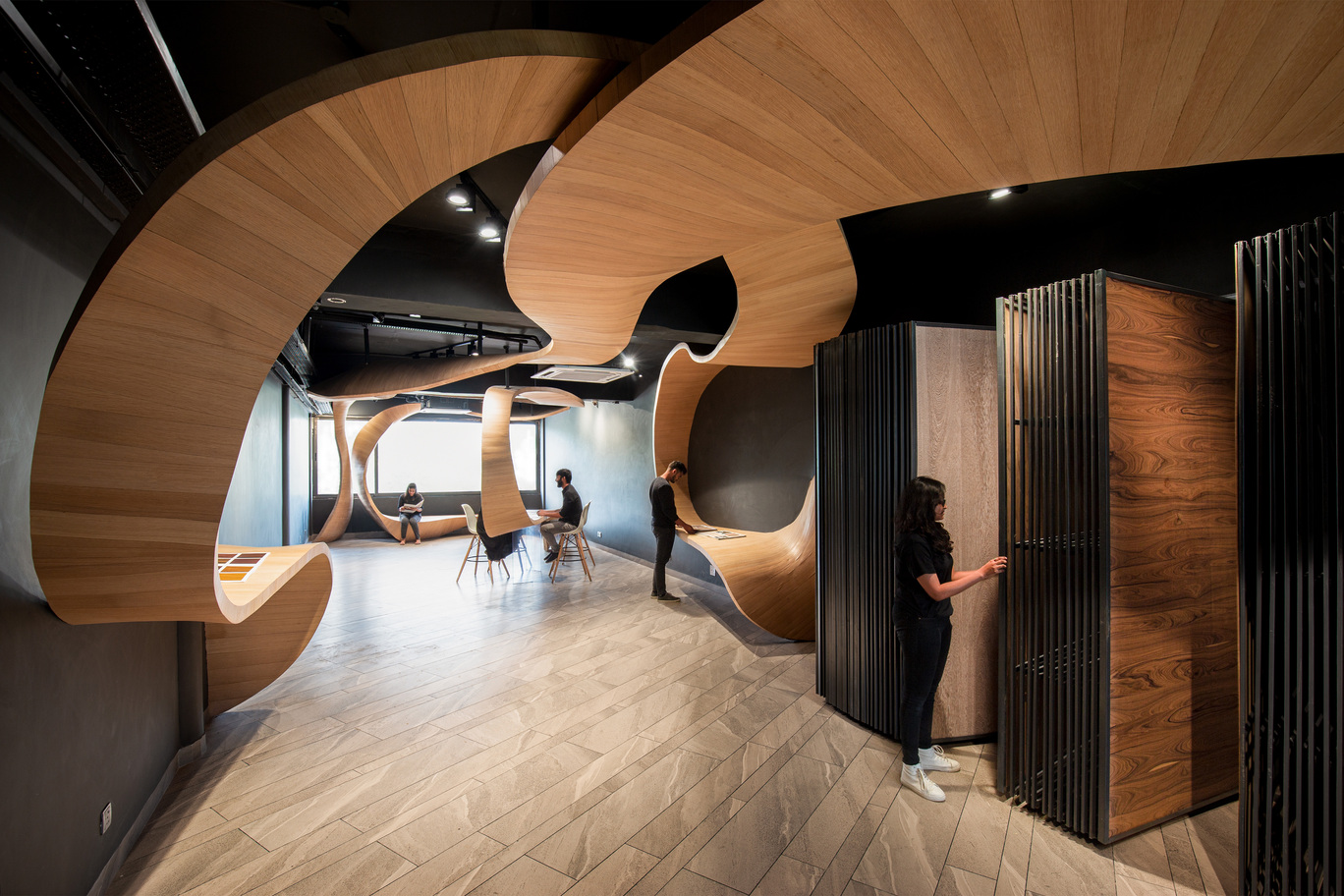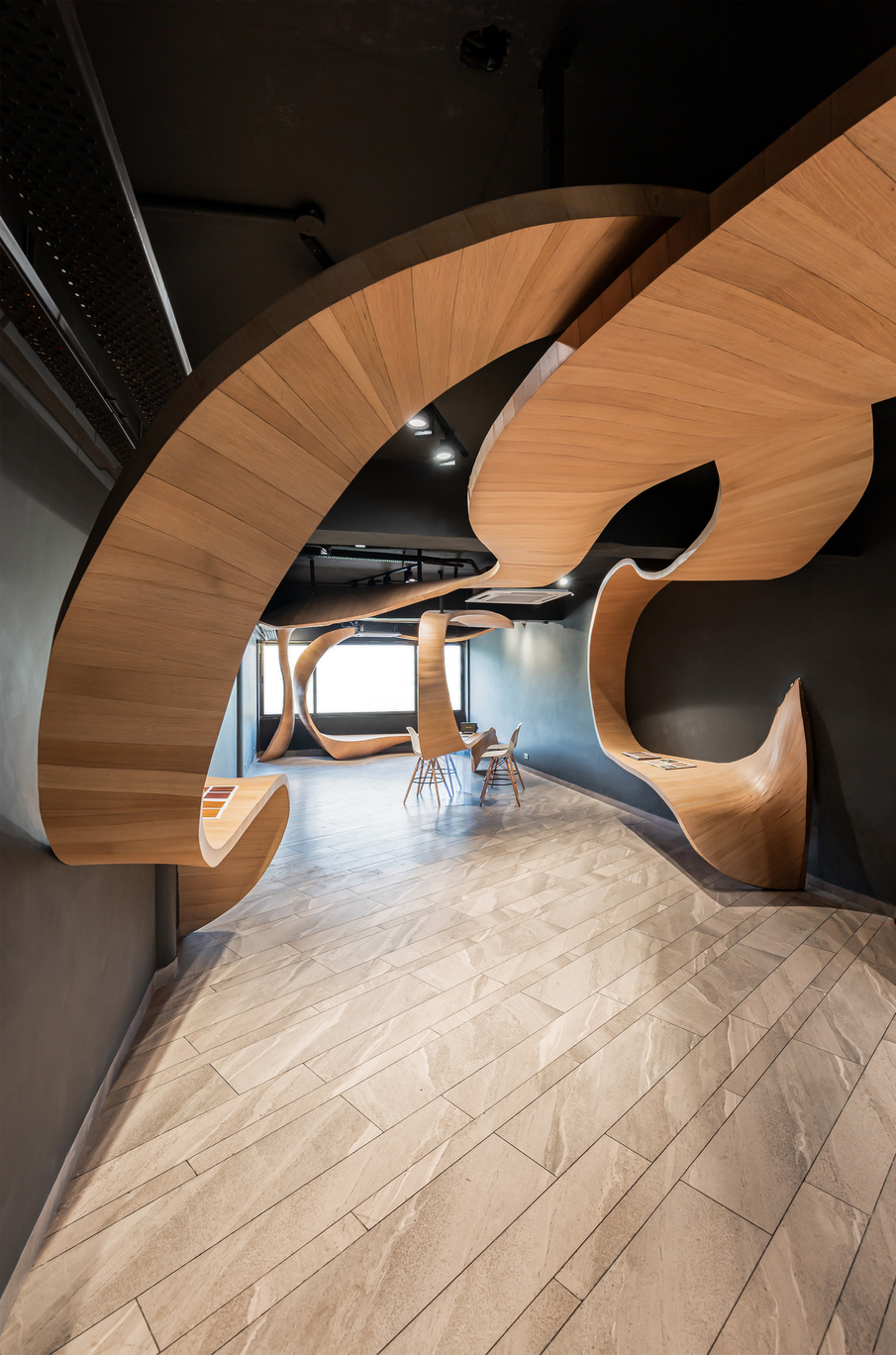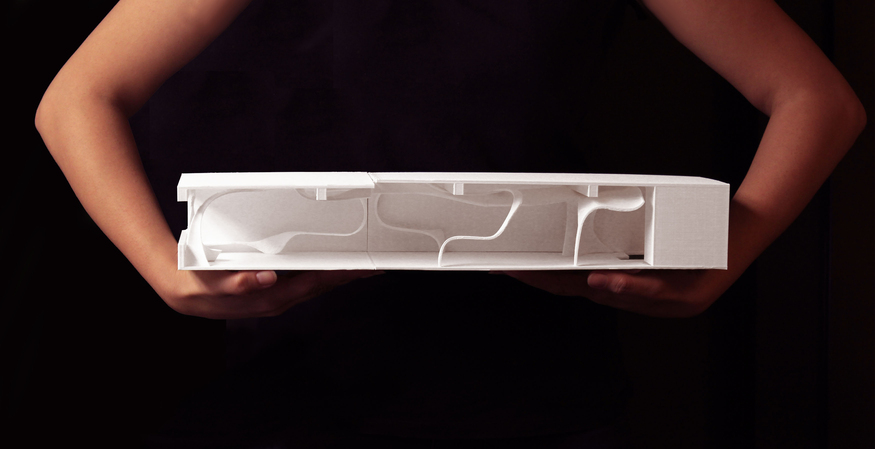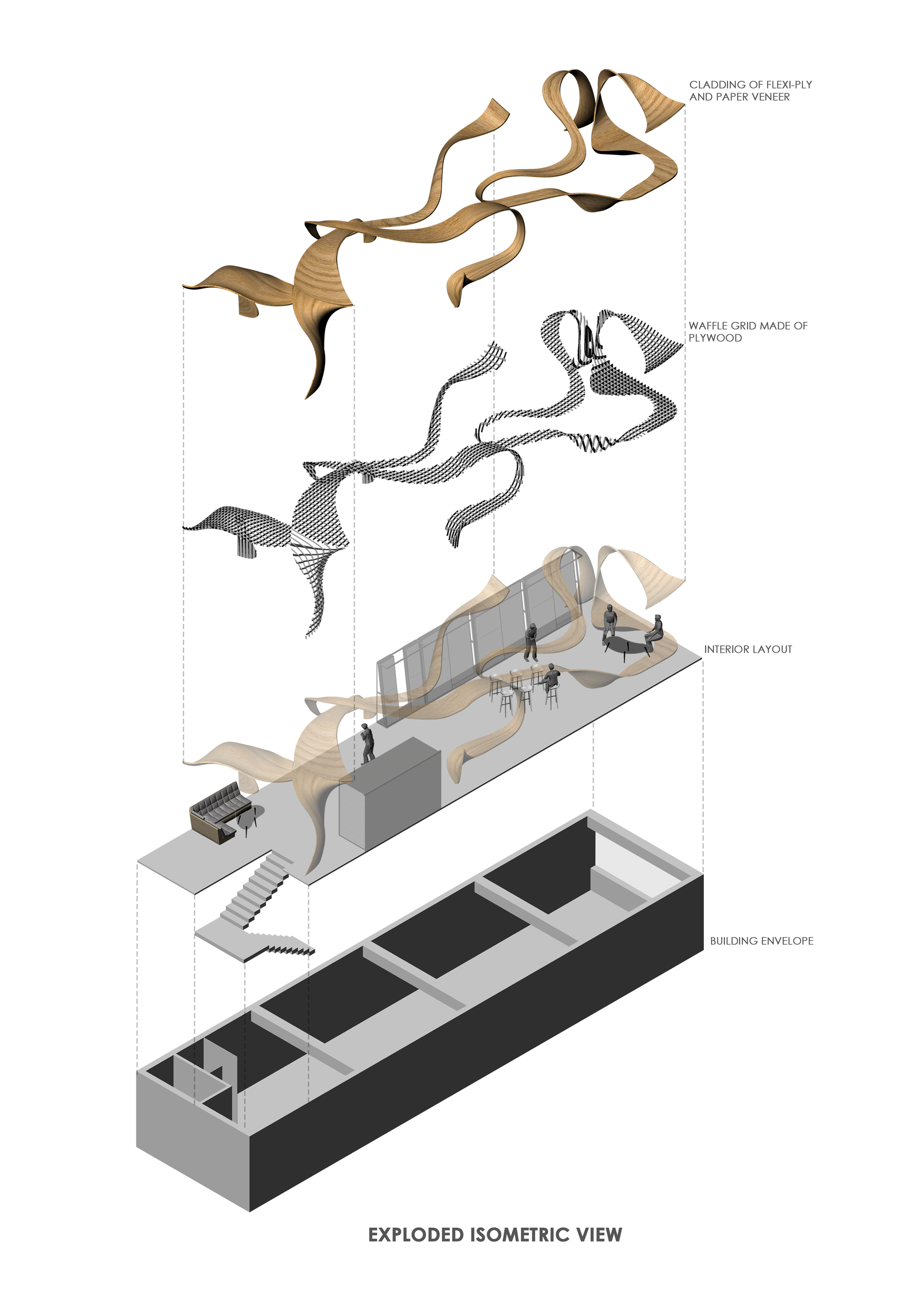
While exploring the limitless possibilities of the wood in design, Ar. Badrinath Kaleru and Ar. Prerna Kaleru of Studio Ardete came up with “Timber Rhyme”- a ribbon-like installation made of hand-carved timber, occupies the first storey of a retail shop in a market complex, Chandigarh. The ribbon is envisioned to blur the boundaries between the static, the movable and the art in-and-on these components of the built space. The most challenging part was to create a walk through the existing 71' by 18' linear block, as one enters from the rear end. The designers felt that the dialogue between a carpenter and a product has diminished because of the changing times and the coming of new engineered materials. This led them to create an elemental ribbon that can be the subject of a dialogue between the carpenter, the end-user and the retailer deepening social engagement. The architects shared with SURFACES REPORTER (SR) more about their project. Have a look:
Also Read: Mass Timber Architecture: Benefits and Common Misconceptions

Connection With the History
One of the most significant architectural elements of Indian history is the way wooden art is used in the various aspects of design and construction. Sutradhar community, according to legend, are the pre-eminent carpenters (also known as 'badhaee'), descended from Maya, the son of Vishwakarma (the divine engineer). These carpenters are distinguished for their unique and exceptional skills. Till date, Vishwakarma day is celebrated in India; and as customary the craftsmen worship their tools.

However, in the past semi-centennial, the government's initiative against deforestation, increased the cost of wood and labour-intenseness of the craft, and thus carved a path for plywood as a cheaper alternative. But is plywood doomed to be replaced by alternative products?
The design explored conventional limitations of the material sold by the client, veneers and plywood, and its protagonist role in a conversation that has existed in the ancient past as well.

The key idea of the designers is a by-product of the concern where dialogue between carpenters and a product perishes and it leads to the formation of Timber Rhyme.
Also Read: This Tiny Prefab Home, Made From Cross-Laminated Timber, Unfolds in 3 Hours | Brette Haus
A Flowing Design
In design, a single-window that frames outside triggering an innate attraction to prospect and sitting space that plays on one's inclination to take refuge.

Both placed opposite to ingress initiates a desire to walk. Represented through the ribbon that pours itself into space, 'variety in a unified continuum' nourishes our concepts.
The site was converted into a spatial matrix, as the ribbon gets developed, by selecting a series of spatial coordinates joined together to formulate doubly curved solids.

This facilitates segmentation of the space, where the eye meets varying focal points each at a different elevation than the previous. The observer's speed is dictated by his surroundings as the form makes its presence felt, carving a new perspective with each viewpoint.
Transcending into an Art Landscape
The role of static elements like partition screens is obfuscated with that of movable furniture. Propounded as a functional art space, a series of 'wooden ribbons' twist and turn to form the display shelves, sitting spaces, meeting table and other design elements each flowing into the other. This transcends the interior into an Art-landscape.
These 'elastic geometries' were realized to be almost self-supporting, threaded from the ceiling using black metal bars. For additional support, translucent acrylic supports were given where the heavy load would be subjected to the ribbon.
How is it Structured?
The ribbon is manifested as a framework of plywood ribs that were digitally fabricated with the help of a definition developed in Grasshopper. To interpolate the doubly curved geometries, these were subdivided into a network of plywood ribs in x and y directions, interlocking at 6 inches intervals.

Together these formed a waffle structure that served as the main framework giving the final shape. To form the structure, CNC milling was used to cut the individual components from 19mm thick plywood ribs. 3mm thick Flexi-ply and 1.5 mm thick paper veneer was used, each cut and handled by the carpenter.

For ease of assembly, each rib was given a unique Alpha-numeric connotation which was etched on ply through CNC milling. They were then jig-sawed in-situ, by the carpenters, in a unidirectional arrangement to correctly align to the next segment.
The resultant was a thin, workable skin of plywood 61 linear feet, ranging in width from 9 inches to 8 feet.
Also Read: Wooden Blocks into ‘Lumbar Curtain’ Facade in Tokyo by Tsukagoshi Miyashita Sekkei
The Final Touch
The end detail lies in the finishing of the ribs where carpentry skill meets technology. Each Flexi-ply joint was filled with wood filler and sanded as required. It is through this last stage of processing that the carpenter takes ownership of technology and uses his experience and 'tell-tale knowledge' for a finished structure.
Lastly, he pastes, strips of paper veneer perpendicular to the curvature of the structure blurring different components of the whole.

The light oak veneer was chosen for its soft grain, drawing attention to other materials while acting as background noise to put materials against each other. This evolved the other half of the name as 'rhyme', an uncertain noise and whispering in ears, subconsciously picked up by the soul, but almost always unaware by the mind.
This amalgamation of technology for cost, time, and ease of making with an advantage of old craft, is a win-win situation for all stakeholders of the project.

As plywood-carpentry meets its entropic spiral, 'Timber Rhyme' hopes to create an opportunity to reimagine the craft of the traditional curves, as an inexhaustible source of inspiration for the next generation of torchbearers of intricate carvings.

Project Details
Project Name: TIMBER RHYME
Architecture Firm: Studio Ardete
Completion Year: 2018
Gross Built Area: 134 SQM
Project Location: Chandigarh (India)
Lead Architects: Ar.Badrinath Kaleru and Ar.Prerna Kaleru
Design Team: Badrinath Kaleru, Prerna Kaleru, Nisha Singh Sarao, Palak Puri
Client: Bansal Ply Chandigarh
Additional Credits
Consultants: Electrical Lighting - The Luminars
Photo credits: Ar.Purnesh Dev Nikhanj
Materials
Plywood: Kitply
Veneer: Turakhias Natural veneer
Paints: Asian Paints
Adhesives: 3M
Lighting: Osram
Tiles: Simpolo
*Text and photos are provided by the architects
About the Firm
Studio Ardete is an emerging, internationally acclaimed multi-disciplinary design practice. Since its inception in 2010 by Badrinath Kaleru and Prerna Aggarwal, both Alumni of IIT Roorkee, the practice tries to explore unexplored ways of space making and products. Making use of personal experiences of founders working across Europe and Japan, with Master architects like Glenn Murcutt, Dominique Perrault, the practice works on varied sizes of projects from small tableware to offices, private houses to hotels. Major Accomplishments of practice include Architecture Master Prize 2018, a couple of Eurasian awards in 2018, published in Retail Design International, a German Publication, Exhibited Furniture collection part of Salone Del Mobile 2018 and 2019. 3 times finalist at the prestigious World Architecture Festival, Finalist at Building of the year 2019 at ArchDaily.
Keep reading SURFACES REPORTER for more such articles and stories.
Join us in SOCIAL MEDIA to stay updated
SR FACEBOOK | SR LINKEDIN | SR INSTAGRAM | SR YOUTUBE
Further, Subscribe to our magazine | Sign Up for the FREE Surfaces Reporter Magazine Newsletter
You may also like to read about:
8000 Pieces of Plywood in this Pavilion by Giles Miller
Plywood Lines Every Surface of Shen’s New Beauty Store in Brooklyn | Mythology
Hardwood Cross Laminated Timber - An Inspiration for Architects
Transparent Wood Can Replace Glass In Future
Architects Badrinath Kaleru and Prerna Kaleru in Conversation with SR
And more…